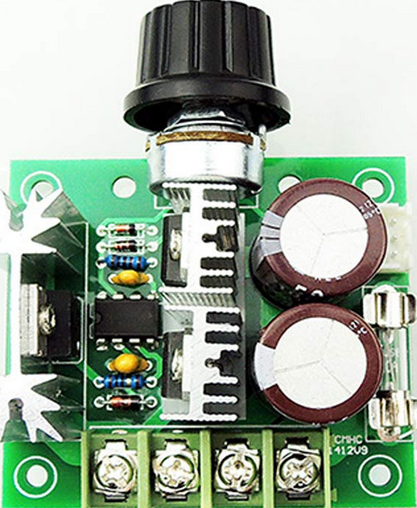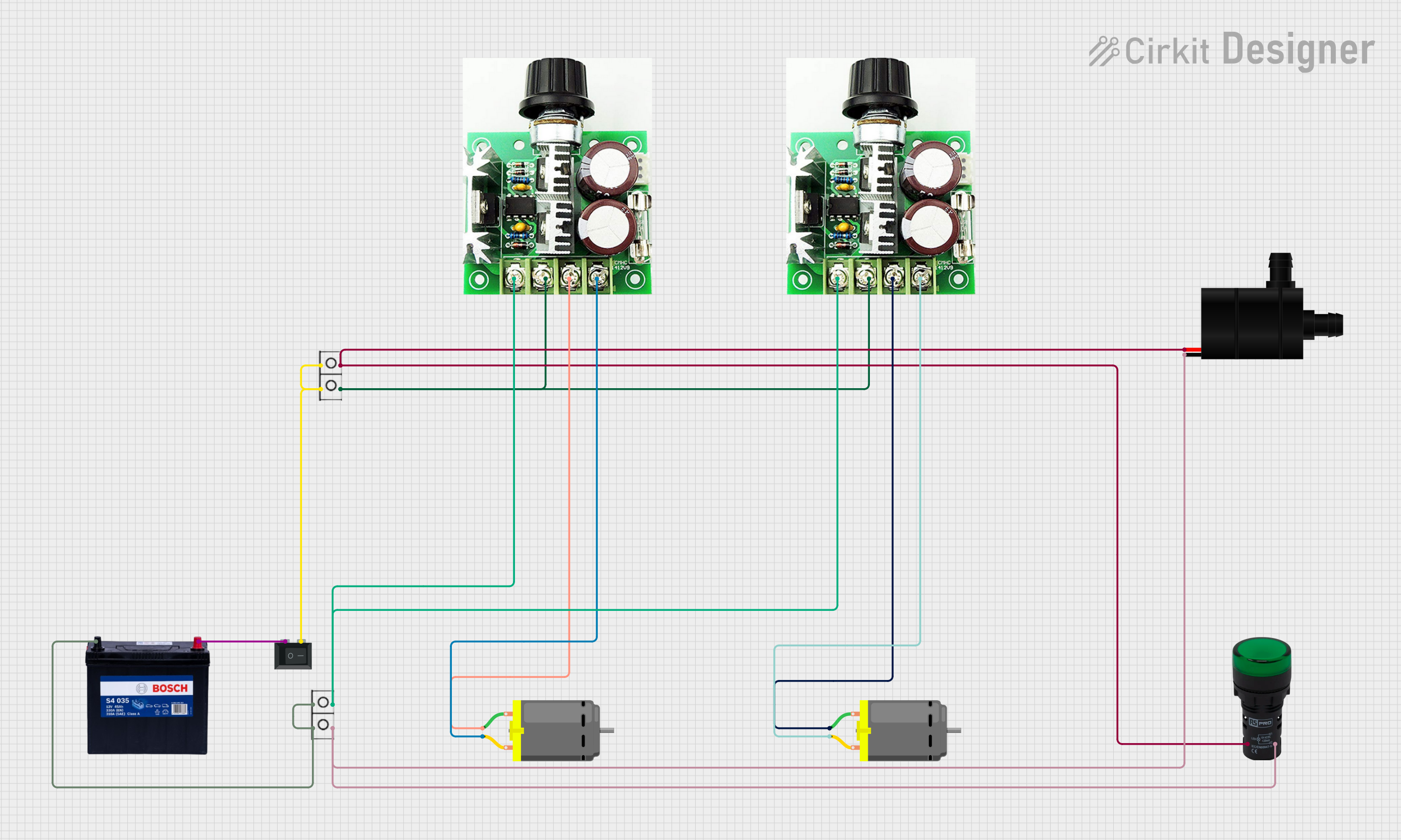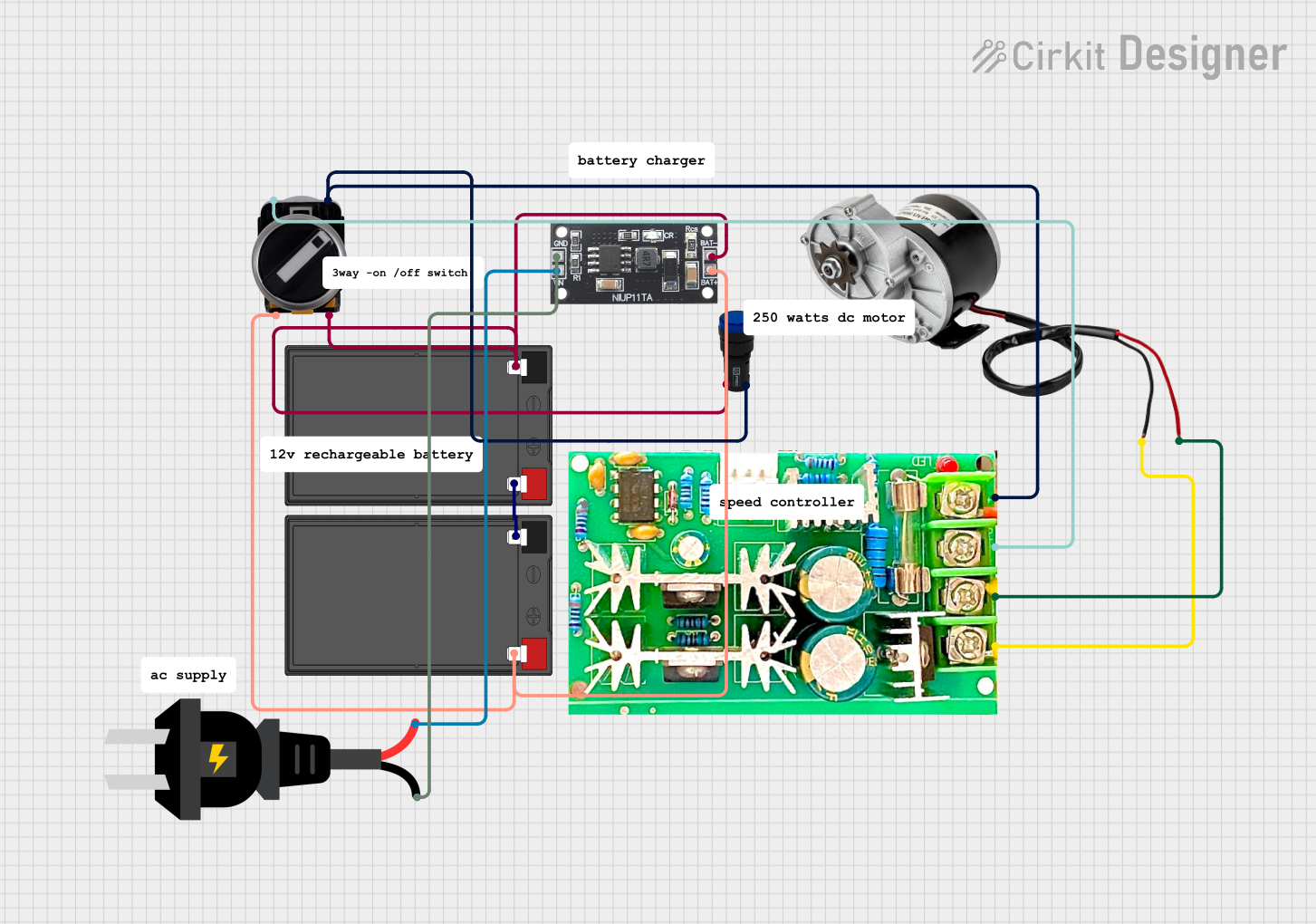
How to Use 12v~40v 10A PWM DC Motor Speed Controller: Examples, Pinouts, and Specs

 Design with 12v~40v 10A PWM DC Motor Speed Controller in Cirkit Designer
Design with 12v~40v 10A PWM DC Motor Speed Controller in Cirkit DesignerIntroduction
The HiLetgo 12V~40V 10A PWM DC Motor Speed Controller is an electronic device designed to control the speed of a DC motor by adjusting the voltage delivered to the motor using Pulse-Width Modulation (PWM). This method of speed control is efficient and results in less heat generation compared to resistive speed control methods. The controller is suitable for a wide range of applications, including fan speed control, conveyor systems, or any application where variable speed control of a DC motor is required.
Explore Projects Built with 12v~40v 10A PWM DC Motor Speed Controller

 Open Project in Cirkit Designer
Open Project in Cirkit Designer
 Open Project in Cirkit Designer
Open Project in Cirkit Designer
 Open Project in Cirkit Designer
Open Project in Cirkit Designer
 Open Project in Cirkit Designer
Open Project in Cirkit DesignerExplore Projects Built with 12v~40v 10A PWM DC Motor Speed Controller

 Open Project in Cirkit Designer
Open Project in Cirkit Designer
 Open Project in Cirkit Designer
Open Project in Cirkit Designer
 Open Project in Cirkit Designer
Open Project in Cirkit Designer
 Open Project in Cirkit Designer
Open Project in Cirkit DesignerTechnical Specifications
Key Technical Details
- Input Voltage: 12V to 40V DC
- Output Voltage: Linear under load
- Continuous Current: Up to 10A
- Max Current: 10A (without a heat sink)
- PWM Frequency: 13kHz
- Duty Cycle Adjustable: 0%-100%
- Control Power: 0.01-400W
- Static Current: 0.02 A (Standby)
- PWM Pulse Width Speed Range: 10%-100%
- Operating Temperature: -20 to +40°C
- Dimensions: 73 x 60 x 27 mm
Pin Configuration and Descriptions
| Pin Number | Description | Notes |
|---|---|---|
| 1 | Motor Output (+) | Connect to DC motor positive lead |
| 2 | Motor Output (-) | Connect to DC motor negative lead |
| 3 | Power Supply Input (+) | Connect to positive terminal of DC power supply |
| 4 | Power Supply Input (-) | Connect to negative terminal of DC power supply |
| 5 | Speed Control Potentiometer | Turn to adjust motor speed |
Usage Instructions
How to Use the Component in a Circuit
Power Supply Connection: Connect a DC power supply to the controller's input terminals, ensuring that the voltage is within the specified range (12V to 40V). Observe correct polarity.
Motor Connection: Connect the DC motor to the controller's output terminals. Again, ensure correct polarity.
Speed Adjustment: Use the onboard potentiometer to adjust the motor speed. Turning it clockwise will increase the speed, while turning it counter-clockwise will decrease it.
Important Considerations and Best Practices
Heat Dissipation: For currents above 10A, it is recommended to use a heat sink to dissipate heat and prevent overheating.
Motor Ratings: Ensure that the motor's voltage and current ratings are compatible with the controller's specifications.
PWM Frequency: Be aware that some motors may produce an audible whine at certain PWM frequencies. This is normal but can be minimized by choosing a motor with a suitable frequency response.
Safety: Always disconnect power before making or changing connections to prevent accidental shorts or component damage.
Troubleshooting and FAQs
Common Issues
Motor Not Turning: Check all connections for proper contact and correct polarity. Ensure that the power supply is within the specified voltage range and that the motor is functioning correctly.
Overheating: If the controller is overheating, reduce the load or attach a heat sink to the controller.
Inconsistent Speed Control: Ensure that the potentiometer is not damaged and that the PWM frequency is compatible with the motor.
Solutions and Tips for Troubleshooting
Check Connections: Loose connections can cause intermittent operation. Ensure all connections are secure.
Test Power Supply: Verify that the power supply is delivering the correct voltage and is capable of supplying sufficient current.
Inspect for Damage: Look for any visible signs of damage to the controller, such as burnt components or traces.
FAQs
Q: Can I use this controller with a 24V motor? A: Yes, as long as the motor's current rating does not exceed 10A.
Q: What is the maximum frequency of PWM this controller can handle? A: The controller operates at a fixed PWM frequency of 13kHz.
Q: Can I use this controller with an Arduino? A: Yes, you can use an Arduino to control the potentiometer or to switch the power supply to the controller on and off, but direct PWM control from the Arduino is not supported by this controller.
Example Arduino Code
// Example code to turn the motor on and off using an Arduino
int motorControlPin = 3; // Connect to the power supply input of the controller
void setup() {
pinMode(motorControlPin, OUTPUT);
}
void loop() {
digitalWrite(motorControlPin, HIGH); // Turn on the motor
delay(5000); // Run for 5 seconds
digitalWrite(motorControlPin, LOW); // Turn off the motor
delay(5000); // Wait for 5 seconds
}
Note: This code example simply turns the motor on and off by controlling the power supply to the motor controller. The actual speed control is still done using the onboard potentiometer.